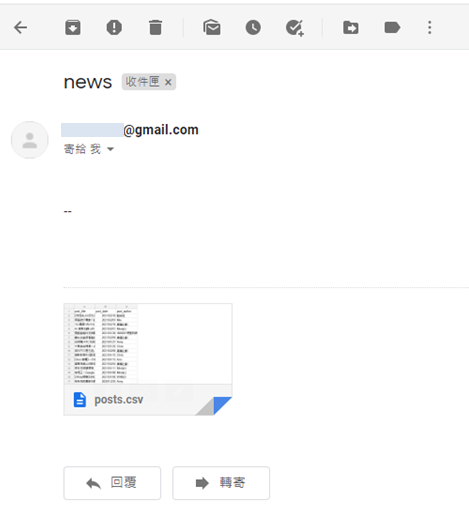在Python網頁爬蟲蒐集資料的過程中,除了能夠將資料存入資料庫或匯出成檔案外,另一個最常應用的場景就是「訊息通知」,也就是在利用Python網頁爬蟲蒐集到所需的資料後,透過訊息通知的管道來推送資料結果。
舉例來說,[Python爬蟲教學]Python網頁爬蟲結合LINE Notify打造自動化訊息通知服務文章整合了LINE Notify服務,來通知使用者Python網頁爬蟲取得的降價訊息,而本文則要來和大家分享另一個訊息通知管道的結合,也就是電子郵件。
本文延續[Scrapy教學8]詳解Scrapy框架爬取分頁資料的實用技巧文章,將爬取的結果存入CSV檔案後,透過Gmail附件郵寄給使用者。在開始之前,大家可以先參考[Python實戰應用]Python寄送Gmail電子郵件實作教學文章的第二節步驟,取得Gmail的應用程式密碼,以便能夠利用它的SMTP(簡易郵件傳輸協定)來發送郵件。本文的重點包含:
- Scrapy網頁爬蟲框架流程
- Scrapy網頁爬蟲專案回顧
- Scrapy MailSender結合Gmail發送郵件
一、Scrapy網頁爬蟲框架流程
首先,來複習一下在[Scrapy教學1]快速入門Scrapy框架的5個執行模組及架構文章中所分享的Scrapy網頁爬蟲框架流程,如下圖:
從上圖可以知道,想要將Scrapy網頁爬蟲取得的資料進行後續處理,就需要在SPIDERS爬蟲程式取得回應結果(6)後,把爬取的資料暫存在ITEMS資料模型,傳遞給ITEM PIPELINE資料模型管道(7,8),來自訂後續資料處理的邏輯。
所以,可想而知,如果想要將爬取的結果匯出成CSV檔案,透過Gmail的附件寄出,就是要寫在ITEM PIPELINE資料模型管道中,也就是Scrapy專案的pipelines.py檔案。
二、Scrapy網頁爬蟲專案回顧
接下來,回顧一下目前Scrapy專案的三個部份,如下:
- 「SPIDERS爬蟲程式(inside.py)」
import scrapy
class InsideSpider(scrapy.Spider):
name = 'inside'
allowed_domains = ['www.inside.com.tw']
start_urls = ['https://www.inside.com.tw/tag/ai']
count = 1 # 執行次數
def parse(self, response):
yield from self.scrape(response) # 爬取網頁內容
# 定位「下一頁」按鈕元素
next_page_url = response.xpath(
"//a[@class='pagination_item pagination_item-next']/@href")
if next_page_url:
url = next_page_url.get() # 取得下一頁的網址
InsideSpider.count += 1
if InsideSpider.count <= 3:
yield scrapy.Request(url, callback=self.parse) # 發送請求
def scrape(self, response):
# 爬取文章標題
post_titles = response.xpath(
"//h3[@class='post_title']/a[@class='js-auto_break_title']/text()"
).getall()
# 爬取發佈日期
post_dates = response.xpath(
"//li[@class='post_date']/span/text()"
).getall()
# 爬取作者
post_authors = response.xpath(
"//span[@class='post_author']/a/text()"
).getall()
for data in zip(post_titles, post_dates, post_authors):
NewsScraperItem = {
"post_title": data[0],
"post_date": data[1],
"post_author": data[2]
}
yield NewsScraperItem以上為Scrapy網頁爬蟲爬取INSIDE硬塞的網路趨勢觀察網站-AI新聞前3頁的文章資訊,其中的實作說明可以參考[Scrapy教學8]詳解Scrapy框架爬取分頁資料的實用技巧文章。
- 「ITEMS資料模型(items.py)」
import scrapy
class NewsScraperItem(scrapy.Item):
# define the fields for your item here like:
# name = scrapy.Field()
post_title = scrapy.Field() #文章標題
post_date = scrapy.Field() #發佈日期
post_author = scrapy.Field() #文章作者- 「ITEM PIPELINE資料模型管道(pipelines.py)」
from itemadapter import ItemAdapter
from scrapy.exporters import CsvItemExporter
class CsvPipeline:
def __init__(self):
self.file = open('posts.csv', 'wb')
self.exporter = CsvItemExporter(self.file, encoding='big5')
self.exporter.start_exporting()
def process_item(self, item, spider):
self.exporter.export_item(item)
return item
def close_spider(self, spider):
self.exporter.finish_exporting()
self.file.close()三、Scrapy MailSender結合Gmail發送郵件
在Scrapy網頁爬蟲框架中,想要實作發送電子郵件的功能,可以使用內建的MailSender模組(Module),透過基本的設定即可達成。並且它是一個基於Twisted框架的非阻斷IO(non-blocking IO),能夠在發送電子郵件時,避免因為非預期的錯誤而導致程式碼卡住。
開啟Scrapy專案的settings.py設定檔,加入以下的Gmail SMTP設定:
MAIL_HOST = "smtp.gmail.com" MAIL_PORT = 587 MAIL_FROM = "申請Gmail應用程式密碼所使用的電子郵件帳號" MAIL_PASS = "Gmail應用程式密碼" MAIL_TLS = True #開啟安全連線
並且,將[Scrapy教學7]教你Scrapy框架匯出CSV檔案方法提升資料處理效率文章中所建立的CsvPipeline資料模型管道設定開啟,如下範例:
# Configure item pipelines
# See https://docs.scrapy.org/en/latest/topics/item-pipeline.html
ITEM_PIPELINES = {
'news_scraper.pipelines.CsvPipeline': 500,
}設定完成後,開啟ITEM PIPELINE資料模型管道(pipelines.py)檔案,引用Scrapy框架的設定檔及MailSender模組(Module),如下範例:
from itemadapter import ItemAdapter from news_scraper import settings from scrapy.mail import MailSender
由於我們要在Scrapy網頁爬蟲將資料匯入到CSV檔案結束後,才進行發送郵件的動作,所以,就需要在CsvPipeline類別(Class)的close_spider()方法(Method)中,來建立Scrapy MailSender物件,如下範例:
class CsvPipeline:
def __init__(self):
self.file = open('posts.csv', 'wb')
self.exporter = CsvItemExporter(self.file, encoding='big5')
self.exporter.start_exporting()
def process_item(self, item, spider):
self.exporter.export_item(item)
return item
def close_spider(self, spider):
self.exporter.finish_exporting()
self.file.close()
mail = MailSender(smtphost=settings.MAIL_HOST,
smtpport=settings.MAIL_PORT,
smtpuser=settings.MAIL_FROM,
smtppass=settings.MAIL_PASS,
smtptls=settings.MAIL_TLS)以上範例第15行利用剛剛在settings.py檔案中所設定的值來建立Scrapy MailSender物件,特別注意其中的關鍵字參數(Keyword Argument)需一模一樣。
接著,指定Gmail的附件,包含「附件顯示的名稱(attach_name)」、「網際網路媒體類型(mime_type)」及「檔案物件(file_object)」,如下範例:
class CsvPipeline:
def __init__(self):
self.file = open('posts.csv', 'wb')
self.exporter = CsvItemExporter(self.file, encoding='big5')
self.exporter.start_exporting()
def process_item(self, item, spider):
self.exporter.export_item(item)
return item
def close_spider(self, spider):
self.exporter.finish_exporting()
self.file.close()
mail = MailSender(smtphost=settings.MAIL_HOST,
smtpport=settings.MAIL_PORT,
smtpuser=settings.MAIL_FROM,
smtppass=settings.MAIL_PASS,
smtptls=settings.MAIL_TLS)
attach_name = "posts.csv" #附件的顯示名稱
mime_type = "application/vnd.openxmlformats-officedocument.spreadsheetml.sheet"
file_object = open("posts.csv", "rb") #讀取匯出的csv檔
#寄出郵件
return mail.send(to=["example@gmail.com"], #收件者
subject="news", #郵件標題
body="", #郵件內容
attachs=[(attach_name, mime_type, file_object)]) #附件
最後,第26行透過Scrapy MailSender模組(Module)的send()方法(Method),寄出網頁爬蟲匯出的CSV資料檔案,同樣關鍵字參數(Keyword Argument)需一樣,執行結果如下圖:
四、小結
在實務上,將Python網頁爬蟲取得的資料匯入到檔案中,並且郵寄給使用者是一個非常常見的應用,而在Scrapy網頁爬蟲框架中,則提供了MailSender模組(Module),讓開發人員只需要透過簡單的設定,即可輕鬆結合SMTP(簡易郵件傳輸協定),像是Gmail等寄送爬取的資料檔案,達到訊息通知的效果。希望本文的教學對於想要在Python網頁爬蟲專案中增加電子郵件功能的讀者有所幫助。
您的Python網頁爬蟲專案都是使用什麼訊息通知管道呢?歡迎在底下留言和我分享交流唷~
如果您喜歡我的文章,請幫我按五下Like(使用Google或Facebook帳號免費註冊),支持我創作教學文章,回饋由LikeCoin基金會出資,完全不會花到錢,感謝大家。







Mike你好,我的程式碼和範例的一樣,但在執行時遇到一個錯誤:
回覆刪除"""
[scrapy.mail] ERROR: Unable to send mail: To=['mymail@gmail.com'] Cc=[] Subject="news" Attachs=1- 502 Server does not support secure communication via TLS / SSL
"""
看錯誤訊息應該和TLS連線有關,上網爬文後還是找不到解答,請問有人可以告訴我哪裡出錯嗎?
我的環境是Python 3.8.8 / Scrapy 2.5.0